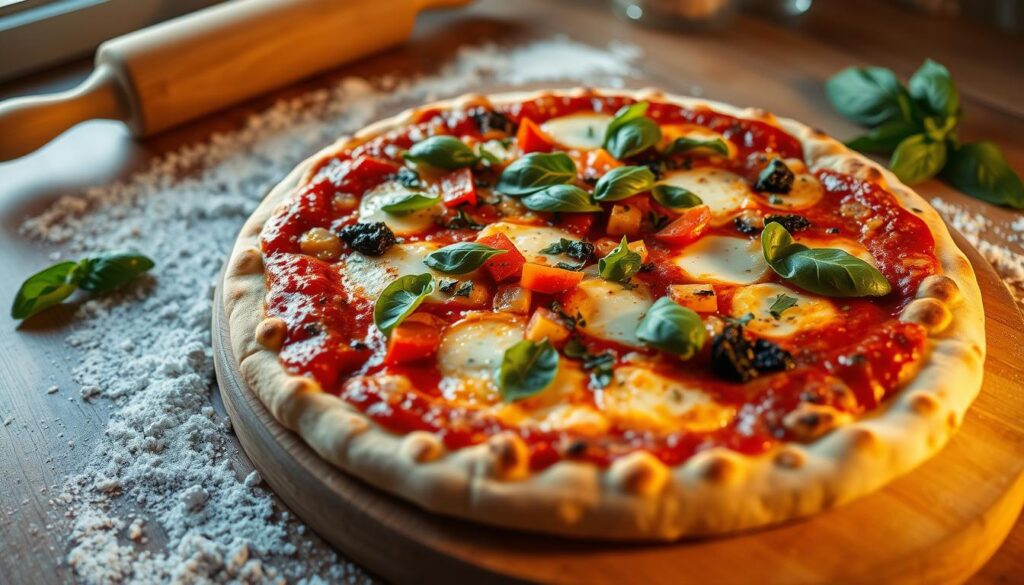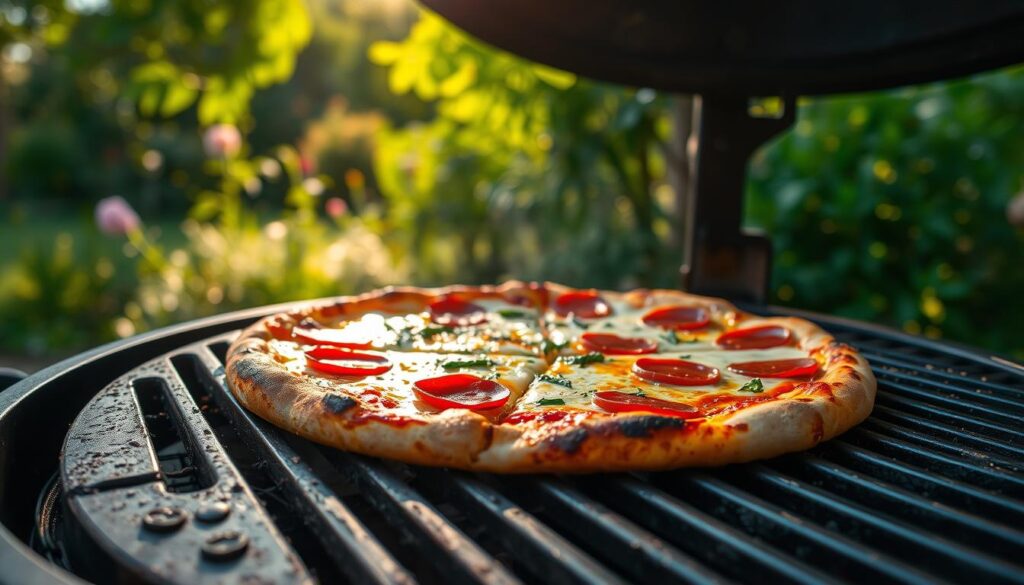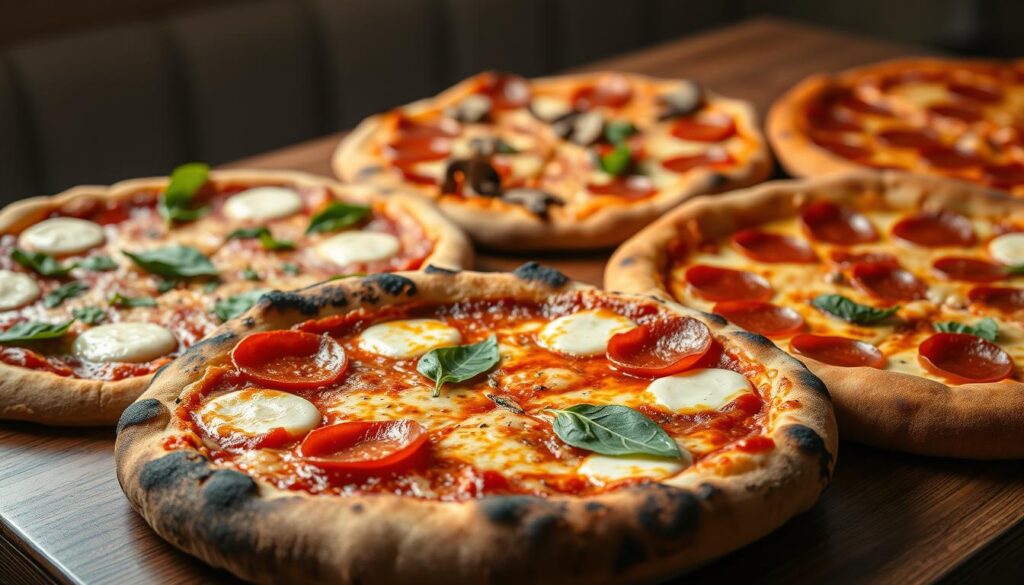
Pizza is undoubtedly one of the most beloved foods around the world, celebrated for its versatility and ability to cater to various tastes. In this article, we will dive into the realm of homemade pizza, exploring a variety of pizza recipes that you can easily recreate in your kitchen. Whether you’re a novice cook or a seasoned pizza enthusiast, our comprehensive pizza cooking tips will guide you through the process of crafting the best pizza at home. Get ready to embark on a fun culinary adventure that will elevate your pizza game!
Key Takeaways
- Explore the versatility of homemade pizza.
- Learn easy pizza recipes for all skill levels.
- Discover essential pizza cooking tips for success.
- Craft the best pizza at home with fresh ingredients.
- Engage in a fun cooking experience with family and friends.
Introduction to Pizza Making
The journey into pizza making begins with an appreciation for its rich history of pizza. Originating in Italy, this beloved dish has been transformed by countless cultures and styles, evolving into the many varieties we enjoy today. Engaging in the art of pizza making brings delightful moments, as families and friends come together to create their own masterpieces.
Understanding pizza making basics is essential for those embarking on this culinary adventure. From selecting the right flour to perfecting the dough, each step is crucial. Beginner pizza recipes often emphasize simplicity, allowing newcomers to experience success and develop confidence in the kitchen.
Creative expression flourishes in pizza making. It’s not just about the ingredients; it’s about crafting a meal that brings joy. Essential equipment, such as a pizza stone and a rolling pin, helps elevate the experience. Embrace the different styles available, from classic Neapolitan to New York-style, as you embark on your pizza-making journey.
Essential Ingredients for Homemade Pizza
Creating the perfect pizza starts with selecting the right ingredients. Flour and cheese play crucial roles in achieving the desired texture and flavor. Understanding pizza flour types and cheese choices can dramatically elevate your homemade pizza experience.
Flour Types: Choosing the Right Base
When it comes to pizza flour types, three main options dominate: 00 flour, bread flour, and all-purpose flour. Each has unique characteristics that influence the final product. 00 flour is a finely milled Italian flour, ideal for traditional Neapolitan pizza. Its high protein content contributes to a chewy and airy crust. On the other hand, bread flour provides a more substantial bite and is perfect for thicker crusts or artisan styles. For versatility, all-purpose flour works well in a pinch and can yield decent results across various pizza recipes.
When incorporating these flours into your dough, accurate measurement is essential. Too much or too little flour can affect the dough’s hydration, impacting its elasticity and flavor. Consider using a kitchen scale for precise measurements, ensuring that your pizza base comes out perfectly every time.
Best Cheese Options for Flavor
The right pizza cheese selection enriches the overall taste. Fresh mozzarella has a creamy texture that melts beautifully, making it a favorite for classic pizzas. Shredded mozzarella offers a convenient option that combines easily with other cheeses. For those seeking depth, blending mozzarella with parmesan or provolone can enhance the pizza-flavor profiles, introducing a richer, more complex taste.
Experimenting with cheese blends allows for creativity. Different combinations can yield unique flavor experiences that cater to various palates. Whether sticking with classic mozzarella or venturing into mixed combinations, selecting the right cheese is crucial for a delightful pizza.
| Flour Type | Characteristics | Recommended Uses |
|---|---|---|
| 00 Flour | Fine texture, high protein | Neapolitan pizza |
| Bread Flour | Chewy, strong gluten | Thick crust, artisan styles |
| All-Purpose Flour | Versatile, moderate protein | General use pizza recipes |
Classic Margherita Pizza Recipe
The Margherita pizza is a timeless favorite, showcasing a simple yet delightful combination of fresh ingredients. To create this classic dish, it’s essential to focus on quality components like San Marzano tomatoes and fresh mozzarella. Follow this comprehensive guide to understand how to make Margherita pizza right at home.
Step-by-Step Instructions
Start with the pizza crust. Here is a detailed approach to the Margherita pizza recipe:
- Prepare the pizza dough: Combine flour, water, yeast, and salt. Knead for about 10 minutes until smooth.
- Let the dough rise: Cover and leave the dough in a warm place for about an hour or until it doubles in size.
- Prepare the pizza sauce: Blend canned San Marzano tomatoes, fresh basil, olive oil, and a pinch of salt to create a robust pizza sauce.
- Preheat the oven: Ensure your oven reaches at least 475°F (245°C) to achieve a crispy crust.
- Assemble the pizza: Roll out the dough on a floured surface. Spread pizza sauce evenly, add slices of fresh mozzarella, and top with basil leaves.
- Bake: Transfer the pizza onto a preheated pizza stone or baking sheet. Bake for 10-12 minutes until golden brown.
Tips for the Perfect Crust
Crafting the ideal crust can elevate your homemade pizza. Implement the following crust cooking tips to improve your pizza crust techniques:
- Use a pizza stone: This helps achieve an evenly cooked crust by mimicking the environment of a traditional pizza oven.
- Roll out dough evenly: Aim for a uniform thickness to ensure even cooking and texture.
- Resting times matter: Allow your dough to rest after kneading to enhance flavor development and texture.
- Experiment with baking times: Monitor closely as different ovens may require adjustments for optimal results.
Gourmet Toppings to Elevate Your Pizza
Transforming your pizza into a gourmet masterpiece is all about choosing the right toppings. Consider experimenting with gourmet pizza toppings that go beyond the usual fare. Unique ingredient combinations bring exciting flavors to the plate. Signature pizza recipes can be elevated with unexpected pairings, such as prosciutto with arugula or creamy gorgonzola paired with sweet pear.
Unique Ingredient Combinations
Creative pizza combinations can impress even the most discerning palates. For instance, spicy buffalo chicken brings a kick, while barbecue sauce combined with grilled chicken offers a delicious twist. Toppings like roasted garlic and caramelized onions work beautifully together, creating a perfect balance of flavors. Don’t shy away from using bold ingredients like blue cheese or truffle oil for added depth.
Seasonal Vegetables for Pizzas
Incorporating seasonal pizza toppings enhances freshness and nutritional value. Opt for vegetables that shine in their peak season. For summer, zucchini slices add a light texture, and for fall, roasted butternut squash provides a warm, sweet flavor. These vegetable pizza ideas not only celebrate the harvest but also invite a colorful array of fresh ingredients to your dish. Preparing these vegetables simply, such as tossing them in olive oil and herbs, brings out their natural flavors, making your pizza a standout creation.
How to Master Dough Making
Dough making serves as the foundation of any great pizza. Understanding the right techniques can lead to delicious results. Focus on effective kneading and proper rising, both of which enhance flavor and structure. Using a stand mixer can simplify the kneading process, while hand kneading offers a tactile experience. Timing plays a vital role in pizza dough rising, contributing to the development of flavors and textures. Fresh yeast can offer distinct characteristics to your dough, elevating it to the next level.
Tips for Kneading and Rising
When it comes to kneading, the main goal is to develop gluten without overworking the dough. Here are some key kneading tips:
- Start with a clean surface and lightly flour it to prevent sticking.
- Use the palm of your hand to push the dough away, fold it back, and rotate it one-quarter turn. Repeat for about 8-10 minutes.
- Allow the dough to rise until it doubles in size, which typically takes 1-2 hours depending on the ambient temperature.
The time spent on pizza dough rising is equally essential for developing the right texture. A longer, slower rising in the refrigerator can enhance the flavor even more. Experimenting with different rising times can yield unique results.
Alternative Crust Recipes
For those exploring alternative pizza crusts, numerous options provide varied flavors and dietary benefits. Here are a couple of popular choices:
| Crust Type | Main Ingredients | Texture | Ideal Toppings |
|---|---|---|---|
| Cauliflower Crust | Cauliflower rice, cheese, and eggs | Crispy and light | Vegetables, low-fat cheese, herbs |
| Whole Wheat Pizza | Whole wheat flour, water, yeast | Nutty and chewy | Meats, robust cheeses, seasonal veggies |
These alternative crusts satisfy various tastes and dietary needs while delivering exceptional flavor. With the right dough making techniques and kneading tips, anyone can create a personalized pizza experience at home.
Grilling: A New Way to Cook Pizza

Grilling pizza offers an exciting twist on traditional methods, providing a way to achieve a smoky flavor and perfect char. Understanding the best practices for grilling is crucial for mastering this technique. Through effective heat management and timing, outdoor pizza cooking can elevate your culinary experience.
Best Practices for Grilling Pizza
To successfully grill pizza, pay attention to the following grilling pizza tips:
- Preheat the Grill: Ensuring your grill is at the correct temperature is essential for a crispy crust.
- Use a Pizza Stone: This helps distribute heat evenly and mimics a traditional pizza oven.
- Roll Dough Thin: A thinner crust cooks faster and is less likely to burn.
- Watch Cooking Time: Be vigilant as pizza cooks rapidly; usually, it takes 5-7 minutes.
- Add Toppings Sparingly: Too many toppings can make the pizza soggy and difficult to handle.
Recommended Tools for Outdoor Cooking
Equipping yourself with the right pizza grilling tools makes a significant difference. Here’s a list of must-have grilling tools for outdoor cooking:
| Tool | Purpose |
|---|---|
| Pizza Stone | Absorbs moisture, helping to create a crispy crust. |
| Long-Handled Spatula | Allows for easy flipping and removal of pizzas from the grill. |
| Grill Thermometer | Ensures the grill reaches the right temperature for cooking. |
| Pizza Peels | Facilitates placing and retrieving the pizza from the grill. |
| Heat-Resistant Gloves | Protects hands when handling hot tools and pizzas. |
Pizza for Any Dietary Preference
Many people today embrace dietary restrictions for various reasons, leading to a growing demand for delicious pizza options that fit these needs. Gluten-free pizza recipes have gained popularity, providing alternatives for those following gluten-sensitive diets, including individuals with celiac disease. Similarly, vegan pizza recipes offer innovative ways to enjoy pizza without compromising values related to animal products.
Gluten-Free Pizza Recipe Options
Embracing gluten-free pizza doesn’t mean sacrificing flavor or texture. By using alternative flours like almond, coconut, or chickpea flour, you can create a delicious crust that caters to pizza for celiac. These options allow for creative flexibility in the kitchen, ensuring you can personalize your gluten-free pizza experience. Below is a sample recipe using almond flour:
For a simple gluten-free crust, combine 1 ½ cups almond flour, 1 egg, and a pinch of salt. Knead until smooth, roll out, and work with your favorite toppings.
Vegan Pizza: Delicious Dairy-Free Alternatives
The rise of plant-based diets has inspired many to explore vegan pizza recipes. Dairy-free pizza cheese made from cashews or nutritional yeast can create creamy, satisfying textures that enhance your pizza without dairy. Additionally, toppings like roasted vegetables, olives, and nuts contribute a variety of flavors.
Experimenting with herbs and spices can elevate your plant-based pizza. Consider using toppings like:
- Fresh basil for an aromatic touch
- Sun-dried tomatoes for a tangy bite
- Artichoke hearts for a burst of flavor
Both gluten-free and vegan pizzas offer diverse and tasty alternatives to traditional recipes, appealing to a broad audience seeking satisfying meals that cater to their dietary preferences.
Creative Pizza Styles to Try

Exploring various pizza styles can elevate your pizza-making experience. From deep dish to thin crust, each brings unique flavors and textures to the table. Distinguishing between these pizza styles begins with understanding their origins and preparation techniques. The right choice often depends on personal preference and the desired flavor profile.
Deep Dish vs. Thin Crust: What’s Your Preference?
Deep dish pizza, a Chicago staple, is known for its thick, chewy crust and generous amount of cheese and toppings, which are layered under the sauce. This pizza style offers a hearty and satisfying meal, particularly appealing during colder months. On the other hand, thin crust pizza celebrates a crisp, delicate base that emphasizes fresh ingredients and lighter toppings. Each method of preparation requires distinct techniques that contribute to the overall pizza experience.
International Pizza Varieties
Pizza around the world showcases a delightful array of international pizza types that reflect regional flavors and ingredients. Here are some notable pizza variations to consider for your next culinary adventure:
- Chicago Deep Dish Pizza – Characterized by its buttery crust and layered toppings.
- New York-style Pizza – Thin, foldable slices with a crispy exterior and soft center.
- Roman-style Pizza – Known for its rectangular shape and airy, crunchy texture.
- Neapolitan Pizza – A traditional Italian style with a thin, soft crust and minimal toppings.
Incorporating these pizza styles into your repertoire can lead to delicious results, allowing creativity to flourish in your kitchen. Each variation presents an opportunity to explore different flavors, thus enriching your overall pizza-making journey.
Conclusion
As we’ve explored throughout this article, the art of making pizza at home is both rewarding and delicious. From understanding essential ingredients to experimenting with gourmet toppings, there’s a world of flavor waiting for you. This pizza cooking summary not only highlights the versatility of pizza but also emphasizes the joy of customizing each pie according to your personal tastes.
Whether you’re just starting or looking to refine your skills, there’s never been a better time to dive into making pizza at home. The tips and recipes shared provide a solid foundation for all home cooks, encouraging everyone to feel confident in their culinary journey. Remember, the beauty of pizza lies in its adaptability, so don’t hesitate to explore new styles and ingredients.
In conclusion, the final thoughts on pizza recipes revolve around creativity, experimentation, and enjoyment. Embrace your unique tastes, gather your family and friends, and make pizza night a delightful experience. With practice and passion, you’ll be crafting perfect pizzas that will impress everyone around your table!
FAQ
What type of flour is best for making pizza dough?
The best types of flour for pizza dough are 00 flour for traditional Neapolitan pizza, bread flour for a chewy texture, and all-purpose flour for versatility. Experimenting with these options can yield delicious results!
How do I achieve the perfect pizza crust?
To achieve the perfect crust, use a pizza stone for even heat distribution, preheat your oven properly, and ensure you let the dough rest. Also, focus on rolling it out gently to keep air bubbles for a light texture.
Can I make pizza on the grill?
Absolutely! Grilling pizza infuses a smoky flavor. Make sure to use a hot grill and consider using a pizza stone to help cook the dough evenly. It’s a fun way to enjoy your pizza outdoors!
Are there gluten-free options for pizza?
Yes! You can use alternative flours like almond, coconut, or chickpea flour to create gluten-free pizza dough. There are plenty of recipes available that will help you achieve a tasty gluten-free crust.
What are some gourmet toppings I can try on my pizza?
Some unique gourmet topping combinations include prosciutto with arugula, pear with gorgonzola, and even spicy buffalo chicken. Don’t be afraid to mix flavors and textures!
How can I make vegan pizza?
Vegan pizza can be made using dairy-free cheese alternatives and a variety of creative toppings like mushrooms, fresh vegetables, nuts, and legumes. There are many recipes that provide fantastic flavor while being fully plant-based!
What are some popular international pizza styles?
Popular international pizza styles include Chicago deep dish, New York-style thin crust, and Roman-style pizza. Each has its own unique characteristics and cooking methods, offering a diverse pizza experience!